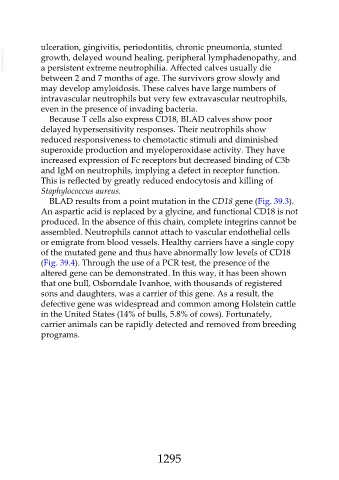Page 1295 - Veterinary Immunology, 10th Edition
P. 1295
ulceration, gingivitis, periodontitis, chronic pneumonia, stunted
VetBooks.ir growth, delayed wound healing, peripheral lymphadenopathy, and
a persistent extreme neutrophilia. Affected calves usually die
between 2 and 7 months of age. The survivors grow slowly and
may develop amyloidosis. These calves have large numbers of
intravascular neutrophils but very few extravascular neutrophils,
even in the presence of invading bacteria.
Because T cells also express CD18, BLAD calves show poor
delayed hypersensitivity responses. Their neutrophils show
reduced responsiveness to chemotactic stimuli and diminished
superoxide production and myeloperoxidase activity. They have
increased expression of Fc receptors but decreased binding of C3b
and IgM on neutrophils, implying a defect in receptor function.
This is reflected by greatly reduced endocytosis and killing of
Staphylococcus aureus.
BLAD results from a point mutation in the CD18 gene (Fig. 39.3).
An aspartic acid is replaced by a glycine, and functional CD18 is not
produced. In the absence of this chain, complete integrins cannot be
assembled. Neutrophils cannot attach to vascular endothelial cells
or emigrate from blood vessels. Healthy carriers have a single copy
of the mutated gene and thus have abnormally low levels of CD18
(Fig. 39.4). Through the use of a PCR test, the presence of the
altered gene can be demonstrated. In this way, it has been shown
that one bull, Osborndale Ivanhoe, with thousands of registered
sons and daughters, was a carrier of this gene. As a result, the
defective gene was widespread and common among Holstein cattle
in the United States (14% of bulls, 5.8% of cows). Fortunately,
carrier animals can be rapidly detected and removed from breeding
programs.
1295

